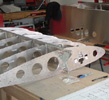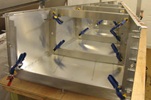


random user submitted photo
Sport ailerons
28 posts
• Page 3 of 3 • 1, 2, 3
Re: Sport ailerons
Rynoth wrote:Adverse yaw... that's what the rudder pedals are for!
Oh yeah! After owning and flying those "lead with the rudder" Challengers for a good numbers of years and then the Aeronca Champ I know a little about adverse yaw. In fact when I went to get my tail wheel endorsement my instructor noted that it was probably the ultralight experience that helped me to realize early that when I was in an airplane my feet still had something to do.
The real fun with my Cleanex is that there isn't much, if any, noticeable adverse yaw so the rudder doesn't get too much to do unless I'm taking off. It takes a boot full of left rudder on take-off with that fire breathing 3.0 Corvair up front!
BTW ... it appears that better weather is sneaking up for the weekend!
Dale Williams
N319WF @ 6J2
Myunn - "daughter of Cleanex"
120 HP - 3.0 Corvair
Tail Wheel - Center Stick
Signature Finish 2200 Paint Job
170.5 hours / Status - Flying
Member # 109 - Florida Sonex Association
Latest video: https://www.youtube.com/watch?v=1VP7UYEqQ-g
-

daleandee - Posts: 877
- Joined: Fri Feb 01, 2013 6:14 pm
Re: Sport ailerons
sonex1374 wrote:peter anson wrote:OK, this is only a guess, but I think the reason that the Sonex doesn't exhibit much adverse yaw is because when an aileron goes up, the gap on the underside of the wing widens causing extra drag, matching the drag of the down-going aileron. If that is correct, longer ailerons shouldn't produce any extra adverse yaw. It has also occurred to me that fitting a trim strip to fill that gap on the lower wing, as was discussed in several other threads, might drastically change the handling characteristics of the aircraft by increasing adverse yaw.
Peter,
You are correct that the shape of the hinge line is largely responsible for the canceling of adverse yaw. The NACA did a study on different hinge designs, and the shape used by Sonex (hinge on one side with a triangular opening on the other) was tested along with many other styles. It turns out that the effect is very similar to a frise aileron, and has the added benefit of being easy to manufacture and very strong (sound like standard Sonex qualities?). I've had the same discussion with others about covering the hinge gaps. I'd expect the feel of the surface to change somewhat if gap seals were installed, but the changes would only really be noticeable at larger control deflections.
Jeff
I agree with the aileron yaw canceling, but, on my Onex I have installed a rudder gap seal and it definetly made a difference in taming the tail, which could be construed as yaw.
OneX 107
N2107X
N2107X
- Onex107
- Posts: 506
- Joined: Mon Mar 24, 2014 6:44 pm
- Location: Peoria, IL
Re: Sport ailerons
Onex107 wrote:I agree with the aileron yaw canceling, but, on my Onex I have installed a rudder gap seal and it definetly made a difference in taming the tail, which could be construed as yaw.
The tail is a bit different than the wing, and feels the effect of adverse yaw a bit differently. The drag created by deflecting the rudder shows itself as a slight decrease in control power. Essentially, the rudder deflects causing lift to be generated by the tail to the side (i.e. yawing the airplane). Deflecting the rudder also has the negative effect of increasing the drag (i.e. increasing induced drag), which pulls the surface backward. This backward pull serves to cancel a small amount of the yawing motion created by the rudder. Effectively, the drag reduces the effectiveness of the yaw.
This effect is not symmetrical. Deflecting the surface in such a way as to open the hinge gap will increase the drag of that gap, and closing the gap decreases it. Although this is the exact effect you want on the ailerons to cancel the unwanted (adverse) yawing motion caused by rolling, it doesn't really work the same on the rudder. Rudder one way (say left rudder that opens the hinge gap) vs the other (e.g. right rudder that closes the hinge gap) simply creates a bit more drag one way than the other. You'll notice this as a more effective rudder in one direction (in this case, right rudder is slightly more effective than left rudder).
Sealing the hinge gap eliminates the drag-creating asymmetry caused by increasing or decreasing the hinge gap, and perhaps reduces the overall drag of the tail itself. These are not bad things for the tail, and would almost certainly provide a better tail. Why doesn't Sonex do this in the first place? Well, my opinion is that the beneficial changes from adding the gap seals are not all that significant, and they feel it doesn't really justify the effort/weight/complexity of gap seals. Plus, using the triangular hinge is just so darn convenient!
So I guess the bottom line is that the Sonex hinge design works amazingly well on the ailerons, and is simple and effective (enough) for the tail surfaces. Is there room for improvement, probably. Is it worth it, perhaps...
Jeff
- sonex1374
- Posts: 605
- Joined: Thu Mar 27, 2014 1:02 am
Re: Sport ailerons
This is why I put a Waiex ventral fin on the bottom of my Sonex.
...not really, I just liked how it looks so I added it. Someday I’ll see if there’s any performance difference without it. It’s just screwed on so its easily removed.
Happy Landings
John
N50NX
...not really, I just liked how it looks so I added it. Someday I’ll see if there’s any performance difference without it. It’s just screwed on so its easily removed.
Happy Landings
John
N50NX
- avee8r
- Posts: 97
- Joined: Sun Aug 12, 2012 11:30 am
Re: Sport ailerons
fastj22 wrote:Ok, I've got to ask you barn door flappers. If you only had 20 degrees of flaps available, could you land your aircraft safely? That's basically what 30 degrees of sport flaps gives you. Or do you need that extra 10 degrees to make a safe landing?
Since nobody answered, I'll bite. Flaps are nice, but not a necessity. Nothing more fun than leaving the flaps up to practice slips in the case of of a failure. Many of the older taildraggers I've flown had no flaps. Piloting skills are learned by practicing for emergencies. Fun stuff.
- N418SX
- Posts: 89
- Joined: Tue Oct 16, 2018 1:46 pm
- Location: Hazlehurst, GA
Re: Sport ailerons
As someone who just completed my first flight with sport acro ailerons, I can say that full flaps (30 degrees) on the shorter flaps gave me a very nice descent rate and were quite effective, I certainly didn't feel that they were lacking in comparison to other planes I've flown.
Ryan Roth
N197RR - Waiex #197 (Turbo Aerovee Taildragger)
Knoxville, TN (Hangar at KRKW)
My project blog: http://www.rynoth.com/wordpress/waiex/
Time-lapse video of my build: https://www.youtube.com/watch?v=Q8QTd2HoyAM
N197RR - Waiex #197 (Turbo Aerovee Taildragger)
Knoxville, TN (Hangar at KRKW)
My project blog: http://www.rynoth.com/wordpress/waiex/
Time-lapse video of my build: https://www.youtube.com/watch?v=Q8QTd2HoyAM
-

Rynoth - Posts: 1308
- Joined: Fri Jul 26, 2013 1:32 pm
- Location: Knoxville, TN
Sport ailerons
I have the standard ailerons but have flown the acro also. The landing speed is close to the same. You just have a faster roll rate
Sent from my iPhone using Tapatalk
Sent from my iPhone using Tapatalk
-

caveman370 - Posts: 69
- Joined: Sun Sep 07, 2014 11:12 am
Re: Sport ailerons
How much flap you need depends on how short your landing strip is, and how high the trees at the approach end are.
David A.
David A.
- DCASonex
- Posts: 935
- Joined: Mon Sep 12, 2011 8:04 pm
- Location: Western NY USA
28 posts
• Page 3 of 3 • 1, 2, 3
Who is online
Users browsing this forum: No registered users and 4 guests







